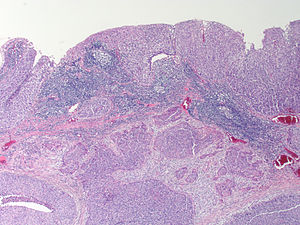Anal squamous cell carcinoma
Jump to navigation
Jump to search
The printable version is no longer supported and may have rendering errors. Please update your browser bookmarks and please use the default browser print function instead.
| Anal squamous cell carcinoma | |
|---|---|
| Diagnosis in short | |
 Anal squamous cell carcinoma. H&E stain. | |
| LM DDx | anal intraepithelial neoplasia, poorly differentiated rectal adenocarcinoma, anal gland adenocarcinoma |
| IHC | p16 +ve |
| Molecular | HPV +ve |
| Site | anus |
|
| |
| Clinical history | +/-men who have sex with men, +/-immunodeficiency or immunosuppression |
| Prevalence | most common anal cancer, overall uncommon |
| Treatment | surgical excision |
Anal squamous cell carcinoma is the most common type of anal cancer.[1]
It is also known as anal squamous carcinoma and squamous cell carcinoma of the anus.
General
- Most common form of anal cancer.[1]
- Overall anal cancer uncommon.[1]
- Strong association with HPV.[2]
Risk factors:[3]
- Men who have sex with men.
- Immunosuppressed.
- HIV infection.
Microscopic
Features:
DDx:
- Anal intraepithelial neoplasia.
- Rectal squamous cell carcinoma.[4]
- Poorly differentiated rectal adenocarcinoma.
- Anal gland adenocarcinoma.
Images
IHC
- p16 +ve.[5]
- CDX2 -ve/+ve.
- PD-L1 +ve in ~40% of cases.[6]
- PD-1 expressed in nearly 70% of tumours.[6]
Sign out
RECTUM, DISTAL, BIOPSY: - INVASIVE SQUAMOUS CELL CARCINOMA.
Notes:
- There is no CAP Cancer Protocol Template.
- AJCC staging is based on size of the tumour.[7]
See also
- Anus.
References
- ↑ 1.0 1.1 1.2 Ghosn, M.; Kourie, HR.; Abdayem, P.; Antoun, J.; Nasr, D. (Feb 2015). "Anal cancer treatment: Current status and future perspectives.". World J Gastroenterol 21 (8): 2294-2302. doi:10.3748/wjg.v21.i8.2294. PMID 25741135.
- ↑ Cornall, AM.; Roberts, JM.; Garland, SM.; Hillman, RJ.; Grulich, AE.; Tabrizi, SN. (Nov 2013). "Anal and perianal squamous carcinomas and high-grade intraepithelial lesions exclusively associated with "low-risk" HPV genotypes 6 and 11.". Int J Cancer 133 (9): 2253-8. doi:10.1002/ijc.28228. PMID 23616200.
- ↑ Kutlubay, Z.; Engin, B.; Zara, T.; Tüzün, Y.. "Anogenital malignancies and premalignancies: Facts and controversies.". Clin Dermatol 31 (4): 362-73. doi:10.1016/j.clindermatol.2013.01.003. PMID 23806153.
- ↑ Nahas, CS.; Shia, J.; Joseph, R.; Schrag, D.; Minsky, BD.; Weiser, MR.; Guillem, JG.; Paty, PB. et al. (Sep 2007). "Squamous-cell carcinoma of the rectum: a rare but curable tumor.". Dis Colon Rectum 50 (9): 1393-400. doi:10.1007/s10350-007-0256-z. PMID 17661147.
- ↑ 5.0 5.1 Gunia, S.; Koch, S.; May, M. (Feb 2013). "Is CDX2 immunostaining useful for delineating anorectal from penile/vulvar squamous cancer in the setting of squamous cell carcinoma with clinically unknown primary site presenting with histologically confirmed inguinal lymph node metastasis?". J Clin Pathol 66 (2): 109-12. doi:10.1136/jclinpath-2012-201138. PMID 23105122.
- ↑ 6.0 6.1 Armstrong SA, Malley R, Wang H, Lenz HJ, Arguello D, El-Deiry WS, Xiu J, Gatalica Z, Hwang JJ, Philip PA, Shields AF, Marshall JL, Salem ME, Weinberg BA (October 2021). "Molecular characterization of squamous cell carcinoma of the anal canal". J Gastrointest Oncol 12 (5): 2423–2437. doi:10.21037/jgo-20-610. PMC 8576238. PMID 34790403. https://www.ncbi.nlm.nih.gov/pmc/articles/PMC8576238/.
- ↑ URL: https://www.cancer.org/cancer/types/anal-cancer/detection-diagnosis-staging/staging.html. Accessed on: June 26, 2023.


